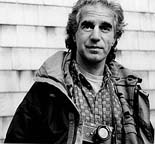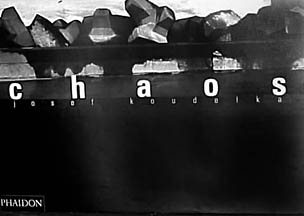|
|
|
|
Book Review by
|
 |
|
|
|
|
Book Review by
|
 |
 Weighing
in at just under 5 pounds, the physical characteristics of Chaos (Phaidon
Press), Josef Koudelka's latest book, are by themselves worthy
of comment. At 110 pages, the book is 12 by 17 inches long, filled with
panorama images which, when spread individually across two pages,
measure 29 inches long. Even more remarkable, there are 61vertical images
(remember, these are full panoramas) out of a total 108 photographs
in this beautifully reproduced book. Weighing
in at just under 5 pounds, the physical characteristics of Chaos (Phaidon
Press), Josef Koudelka's latest book, are by themselves worthy
of comment. At 110 pages, the book is 12 by 17 inches long, filled with
panorama images which, when spread individually across two pages,
measure 29 inches long. Even more remarkable, there are 61vertical images
(remember, these are full panoramas) out of a total 108 photographs
in this beautifully reproduced book.
The combined effect of the size and weight of this book made my usual flipping from the back of a photography book toward the front impossible. And even if you have the strength to hold the book at arms length, the largest images are beyond any reasonable limits of what could be considered proper viewing distance. This, alone, forced me to put the book down and start at the beginning. Intentional or not, the design of this book itself, is a declarative statement. I had to begin with the finality of letting go of the way I usually look at a book of photographs. Panorama photographs have been around for a long time. In the last few years, this format has become very popular. However, the shape of the panoramic frame is so spectacular, I sometimes find it difficult to asses whether an image works or not.There are times when the relationship between form and content in these images is misleading, where a photograph appears to be strong simply because it looks so spectacular. This is not true in Koudelka's case. In fact, this body of work is so compelling, so purely seen, it almost neutralizes any emphasis on the frame. This is not to say that Koudelka does not delight in the panorama format. Quite the contrary. But Koudelka is Koudelka, and he has more important fish to fry. When I look at the images in Chaos, I hear the music of Miles Davis, of darkness and beauty. One could argue that the subject of this work is desolation and emptiness. And certainly these are part of almost every image. But the depth and breadth of this work comes from a kind of self imposed challenge, one which wonders how dark an image can be and still maintain beauty. And how long can a photographer sustain this kind of imagery without being repetitive or technical? Jazz musicians face a similar problem when it's their turn to solo. With absolute certainty, Koudelka hits a dazzling low note with this work (in his case, think of an acoustic bass or cello, drawn with a long bow) and holds it with complete confidence right through the resolution of the note itself, which in this case is the entire length of the book. It's astonishing. Only Koudelka could discover a celestial sky living in what looks like a piece of shattered tin hanging in a desolate cityscape (p41). Or a bombed out building, walls riddled with bullet holes which, in a more predictable image by any other photographer, would be a statement about the horrors of war. But for Koudelka, it is here that the past and eternity come together in the same moment. This relationship is not forced. It is there, wholly recognized and documented for us to witness(p17). There is, of course, the occasional image grounded in a reality that is more familiar to the rest of us. A large statue of Lenin is tied onto a huge barge floating in a waterway under a dreary, gray sky. There are no people, no indication of movement or direction. Where is Lenin going? Has he arrived at his resting place? This haunting image speaks not simply to the past, or a bygone era, but of unfinished business, or unfortunate things that will linger and may never die (p59). Unlike his previous work, there are only four photographs with people in them. And in each case, they are not only anonymous, but almost freakish, living strangely out of time. That is, out of any time we might be familiar with. Although I find this entire body of work compelling, there is one flaw in the book. With a visual vocabulary as extensive and poetic as Koudelka's, I am used to seeing his photographs displayed as individual images, without any direct referencing from one image to another. Exiles, his last book, is a perfect example of this done well, where he used one image per spread. In Chaos, because there are as many as three vertical images on a single page, it is virtually impossible for them not to inform each other. This creates a distraction as well as a disruption in the cadence and rhythm of the book. Are these groupings intentional or the result of compromises forced by the design and format of thepanorama itself? Either way, I found myself covering the verticals with white paper so I could view them individually. This said, Chaos is a virtuoso performance by Koudelka, not simply because it shows us the full extent of his command and understanding of the medium of photography. But by exhibiting his unique ability to venture far from the melody (documentary photography) without losing site of it, he continues to define what a documentary photograph can be: a reflection so full that it is at once deeply human, richly poetic, and modestly spiritual in the broadest sense. A Jungian analyst once told me that, though
we all enjoy interpreting our dreams, what a dream really wants is another
dream, and another and another. This
is also true about photographs. And no one seems to understands this better
than Koudelka himself.
Nubar Alexanian
|
| CONTENTS
PAGE |
| Contents Page | Editorials | The Platypus | Links | Copyright |
| Portfolios | Camera Corner | War Stories | Dirck's Gallery | Comments |
| Issue Archives | Columns | Forums | Mailing List | E-mail The DJ |